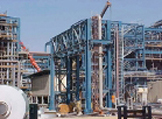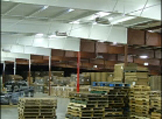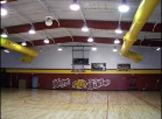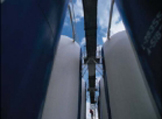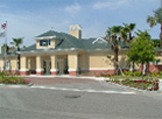Painting Terms

Learn Painting Terms - W
Browse Our Painting Terms
Wainscot - The lower part of an interior wall when it is finished differently from the remainder of the wall.
Waiver - The intentional relinquishment of a known right.
Wale - A horizontal beam.
Walk - A path specially arranged or paved for walking.
Walk-Through - A final inspection of the work, before final payment, to look for and document problems that need to be corrected.
Walk-Up - A two or more story apartment building or living unit without an elevator.
Walkways - Designated areas for foot traffic.
Wall - A member, usually vertical, used to enclose or separate spaces.
Wall Angle - (1) An L-shaped aluminum angle used as the wall termination of T-bar suspended ceiling systems to support the perimeter acoustic tiles. (2) A structural steel angle attached to a masonry wall.
Wall Bracket - A wall-mounted support for shelving or other object.
Wall Cabinet - Case, box, or piece of furniture which mounts on a wall, commonly with shelves and doors, used for storage.
Wall Cladding - Exterior wood or metal building siding.
Wall Covering - Any of a variety of final applications to finish a wall surface.
Wall Fabric - Wallpaper or other fabric used to cover or finish off an existing wall.
Wall Finish - The final planing, sanding, staining, varnishing, waxing, or painting of a wall.
Wall Grille - A wall grating used to cover an opening as protection or as an ornament.
Wall Louver - Openings in walls for ventilating spaces.
Wall Out - When a painter spray paints the interior of a building.
Wall Plaster - A paste -like composition that hardens on drying and is used for coating walls.
Wall Railing - A band of ornamental wood installed horizontally.
Wall Shear Stress - The shear stress at the wall or surface caused by a liquid moving past it.
Wall Sheathing - The first layer of covering on an exterior wall, fastened to the wall studs.
Wall Size - A solution such as glue, starch, casein, shellac, varnish or lacquer, used to seal or fill pores of wall surface to stop suction, counteract chemicals or stains and prepare surface for paint, paper or fabric.
Wall System - A modular set of shelves and cabinets that can be arranged along a wall in various combinations.
Wallboard - Large, rigid sheets of wood pulp, gypsum, pressed cellulose fibers, gypsumboard, plywood, or similar materials , used in place of plaster in interior surfaces.
Wallpaper - A decorative paper for applying to the walls of a room.
Wallpaper Paste - An adhesive used for attaching wallpaper.
Wall-to-Wall - Covering the entire floor area.
Walnut - The richly grained moderate reddish-brown wood of the walnut tree, used for veneers, cabinetmaking, and moldings.
Walnut Door - A door which has a veneer of walnut.
Walnut Veneer - An overlay of a thin layer of walnut wood for outer finish or decoration.
Warehouse - A building or room used for storage.
Warm Colors - Colors in which red -orange predominates; so termed because of the association with fire, heat, and sunshine.
Warming Colors - Any color except green may be warmed by adding red; green is warmed by adding yellow.
Warranty - In painting there are two general types of warranties. One is provided by the manufacturer of a paint or coating. The second is a warranty for the labor.
Wash Coat - A very thin coat of finishing material, usually shellac.
Wash Fountain - A waist high sink which supplies a steady stream of water to cleanse the hands.
Wash Primer - A thin inhibiting paint usually chromate pigmented with a polyvinyl butyrate binder.
Washability - The ability of a paint to be easily cleaned without wearing away.
Washing - (1) Rapid dissolution or emulsification of a paint film when wet with water. (2) Erosion of a paint film after rapid chalking.
Waste Handling - The act or process of transporting or removing rubbish.
Waste Receptacle - A container for the temporary storage of rubbish.
Watchman - A guard who keeps watch over a certain area.
Water - (1) A colorless, transparent, odorless compound of hydrogen and oxygen, H2O. (2) A liquid composed of two parts of hydrogen and sixteen parts oxygen by weight.
Water Absorption - (1) The amount of water absorbed by a material under specified test conditions; expressed as weight percent of the test specimen. (2) The amount of water ingested into the core and surface papers of gypsumboard; expressed as a percent of water added over dry weight.
Water Based Paint - Any paint made with acrylic, vinyl or latex resins, and thinned with water. It dries more quickly than oil-based paint, has a relatively low odor and cleans up easily.
Water Blast Cleaning - A blast cleaning process utilizing water, which is an alternative to air abrasive blast cleaning for wood, concrete, metal, or other surfaces. Water blast cleaning can be used with or without abrasive injection.
Water Blaster - A machine that uses pressurized water to remove old paint. Also called power washer.
Water Blasting - Blast cleaning using high velocity water.
Water Conditioning - Virtually any form of water treatment designed to improve the aesthetic quality of water by the neutralization, inhibition or removal of undesirable substances.
Water Curable Coating - A coating that cures when it comes in contact with water.
Water Emulsions - Mixture of pigment and synthetic resin in water with low solvent emission, low fire hazard and toxicity and good durability and chemical resistance.
Water Paint - A paint in which the vehicle is a water emulsion and in which water is used as thinner.
Water Proofing - Treatment of a surface or structure to prevent the passage of water under hydrostatic pressure.
Water Reducible - Ability to be diluted with water or a water/cosolvent mixture.
Water Repellant - Any finish that prevents penetration of water into the substrate.
Water Repellent Preservative - A liquid applied to wood to give the wood water repellant properties.
Water Softener - Removes hardness from water through an ion exchange of sodium with calcium and magnesium.
Water Softening - The removal of calcium and magnesium, the ions which are the principle cause of hardness, from water.
Water Spotting - Change in surface appearance resulting from the action of water standing on the paint film or substrate. Spotting usually is caused by water sensitivity of the coating, although the defect can be the result of dissolved material deposited as water evaporates.
Water Stain - A stain or dye which is soluble in water.
Water Table - The level of the top of the zone of saturation, in which free water exists in the pores and crevices of rocks and other earth strata.
Water Thinned Paint - A paint with water as the vehicle.
Water Tube - A tube in a boiler having the water and steam on the inside and heat applied to the outside.
Water Vapor - Moisture existing as gas in the air.
Water White - Transparent and colorless like water.
Waterproof - So constructed or protected that moisture will not interfere with its successful operation.
Waterproof Membrane - An impermeable layer of plastic film, roofing material, bitumen, or other material placed to stop transfer of water or water vapor.
Waterproofing - (1) The act or process of making something waterproof. (2) A coating capable of stopping penetration of water or moisture.
Watertight - So constructed that moisture will not enter the enclosing case.
Wate-Thinned Paint - A paint whose thinner is mainly water; the binder may be a material that (1) requires water for setting, e.g., portland cement; (2) which is soluble in water, e.g., casein; (3) which is emulsifiable in water, e.g., flat wall paint binders.
Wave Length - (1) The distance between successive similar points on two wave cycles. (2) In color, the computed distance between vibrations of light that produce visible color sensation on the eye; in the visible spectrum, red -orange has the longest wave length; violet the shortest; wave lengths are measured in millimicrons; wave lengths shorter than violet are called ultraviolet; wave lengths longer than red -orange are called infrared.
Waveguide - A system of material boundaries capable of guiding electromagnetic waves. A transmission line comprising a hollow conducting tube within which electromagnetic waves are propagated on a solid dielectric or dielectric-filled conductor.
Wavy Grained Wood - Wood in which the fibers collectively take the form of waves or undulations.
Wax - (1) A fatty material obtained from the honeycombs of bees or from similar plant, animal, or mineral substances; used for providing an attractive, protective coating, as for wood; waxes may be used by themselves or combined with other ingredients to make certain polishes, paints, varnishes, and paint removers. (2) Ingredient in many lubricating oils which may separate from the oil if cooled enough.
Wax Bleeding - Migration of waxy additives used in reconstituted wood products to the surface causing discoloration. Usually caused by exposing hardboard to weather too long before painting; not priming; using wrong primer; or inadequate paint film thickness.
Weak Base Load Faction - The sum of the chloride, sulfate, and nitrate in a given water.
Wear - Loss of material from a surface by means of some mechanical action.
Weather Delay - Lack of painting progress caused by inclement weather.
Weather Etch - A method of improving the adhesion to a metal substrate by allowing it to weather naturally before painting.
Weather Resistance - The ability of a coating to retain its appearance and integrity in the face of various weather conditions.
Weather Vane - A vane; a moveable device for showing the direction of the wind.
Weatherability - Capability of withstanding the weathering process.
Weathering - Paint film deterioration as a result of exposure to the weather.
Weathering Steel - A steel alloy that forms a tenacious, self-protecting rust layer when exposed to the atmosphere.
Weatherization - Work on a building exterior in order to reduce energy consumption for heating or cooling. Work involving adding insulation, installing storm windows and doors, caulking cracks and putting on weather-stripping.
Weatherometer - A testing device intended to simulate atmospheric weathering.
Weatherproof - So constructed that exposure to the weather will not cause damage or loss of function.
Weatherproof Box - An electrical outlet or switch box which has been manufactured to withstand the outside elements.
Weatherproof Cover - A protective layer constructed so that exposure to the weather will not interfere with successful operation.
Weatherproof Duct - An enclosure for wires or cables constructed so that exposure to weather will not interfere with successful operation.
Weatherproof Insulation - A material used to rce heat transfer, constructed so that exposure to the weather will not interfere with its successful operation.
Weatherstrip - Narrow sections of thin metal or other material installed to prevent the infiltration of air and moisture around windows and doors.
Web - The vertical plate connecting the top and bottom flanges of a metal beam.
Web Belt - Commonly a used military type belt adapted to carry hand tools at the jobsite.
Web Members - The vertical and angular members between the top and bottom chords of a truss.
Wedge - A piece of material, such as wood or metal, tapering to a sharp edge that is driven between two objects or parts of an object to secure or separate them.
Weep Hole - A small opening, the purpose of which is to permit drainage of water that accumulates inside a building component.
Weep Screed - A plaster screed at the bottom of an exterior stucco wall that is designed to allow moisture to seep out.
Weeping Joints - A masonry joint treatment in which mortar extruding from the joint in laying is not cut off, but is allowed to harden; gives informal rustic appearance but difficult to waterproof.
Weir - (1) A dam in a stream over which water flows; see Crest. (2) A dam in a stream to raise the water level or to divert the stream. (3) An orifice through which the liquid only partially flows.
Weld - (1) A joint between two pieces of metal formed by fusing the pieces together, usually with the aid of additional metal melted from a rod or electrode. (2) To join two pieces of metal together by heating until fusion of material either with or without filler metal. (3) The joining of components together by fusing. In thermoplastics, refers to bonding together of the membrane using heat or solvents.
Weld Bead - A weld deposit resulting from a pass.
Weld Cracking - Cracking that occurs in the weld metal.
Weld Decay - Not a preferred term meaning integranular corrosion usually of stainless steels or certain nickel-base alloys, that occurs as the result of sensitization in the heat affected zone during the welding operation.
Weld Inspection - Methods to determine existence and extent of defects and discontinuities in welds.
Weld Slag - Deposits formed during welding.
Weld Spatter - Beads of metal left adjoining a weld.
Weld Test - Welding examination or inspection; the loading of welds to determine load capacity of welds is not normal practice.
Weld X-Ray - To examine, treat, or photograph the connection of surfaces that have been welded together.
Weldability - The capacity of a metal to be welded under the fabrication conditions imposed into a specific, suitably designed structure and to perform satisfactorily in the intended service.
Welded Joint - A union of two or more members produced by the application of a welding process.
Welded Pipe - Piping where connections and fittings are welded.
Welded Railing - Railing sections with the components fastened with welds.
Welded Truss - Trusses with components fastened together with welds.
Welded Wire Fabric - A series of longitudinal and transverse steel wires arranged substantially at right angles to each other and welded together at the intersections, in sheets or rolls, used to reinforce mortar and concrete.
Welder - One who is capable of performing manual or semiautomatic welding operations based on training, experience, testing, or certification, or any combination of these.
Welding - Fusing metallic parts by heating and allowing the metals to flow together.
Welding Process - The joining of materials by the application of heat or friction. Usually involves the localized fusion of both contacting surfaces.
Welding Technique - The details of a manual, machine or semi-automatic welding operation which within the limitations of the prescribed joint welding procre are controlled by the welder.
Welding Test - The act or process of testing the strength of a weld.
Welding Torch - A device used in gas welding or torch brazing for mixing and controlling the flow of gases.
Weldment Connection - The assembling together of pieces by welding to create a unit.
Well - (1) A pit or hole sunk into the earth to reach a supply of water. (2) An open space extending vertically through floors of a structure.
Wellpoint - A perforated pipe surrounded by sand to permit the pumping of ground water.
Wet Abrasive Blast Cleaning - An abrasive blast cleaning operation in which water is added. Water may be injected into the abrasive stream or applied externally to the abrasive stream as it exits the blast nozzle. Wet abrasive blast cleaning creates less dust than open abrasive blast cleaning. Inhibitors may be added to the water or used in a follow-up rinse to prevent flash rusting.
Wet Adhesion - The ability of dry paint to adhere to the surface in spite of wet conditions. This is of particular importance for exterior paints.
Wet Areas - Interior or exterior tiled areas subject to periodic or constant wetting; examples are pools, exterior walls, roofs, exterior paving, and interior floors.
Wet Cell Battery - Cell or connected group of cells that converts chemical energy into electrical energy by reversible chemical reactions.
Wet Edge - Fluid paint boundary.
Wet Edge Retention - The length of time a newly applied coating can stand, then be brushed or rolled again, without showing lap marks.
Wet Edge Time - The length of time before a stretch of paint sets up without showing lap marks when the painter applies the next stretch.
Wet Film Gauge - A device for measuring wet film thickness.
Wet Film Thickness - Thickness of a liquid film immediately after application, before it begins to dry.
Wet Film Thickness Gage - A device used for measuring the wet film thickness of a coating.
Wet Location - A location subject to saturation with water or other liquids, such as exposed to weather, washrooms in garages and like location; installations underground or on concrete slabs or masonry in direct contact with the earth are wet locations.
Wet Location Fluorescent - A watertight fluorescent fixture that is sealed to protect against moisture.
Wet Sand - To smooth a finished joint of sheetrock with a coarse wet sponge. A preferred method to rce dust created in the dry sanding method.
Wet Sandblasting - The incorporation of water into the sandblasting operation in order tominimize dust.
Wet Spray - Paint spraying so that surface is covered with paint that has not started to dry.
Wet Sprinkler System - A sprinkler system that is filled with water at design pressure for immediate use upon activation.
Wet Steam - Steam containing moisture.
Wet-Bulb Temperature - The lowest temperature which a water wetted body will attain when exposed to an air current. this is the temperature of adiabatic saturation, and can be used to measure humidity.
Wetness - A term used to designate the percentage of water in steam. also used to describe the presence of a water film on heating surface interiors.
Wettability - A condition of a surface that determines how fast a liquid will wet and spread on the surface or if it will be repelled and not spread on the surface.
Wetting - The ability of a vehicle to flow onto the surface in order to achieve a good bond.
Wetting Agent - A substance capable of lowering the surface tension of liquids, facilitating the wetting of solid surfaces and permitting the penetration of liquids into capillaries.
Wetting Oils - Products used to promote adhesion of applied coatings when all mill scale and rust cannot be removed.
Wharf - A structure that provides berthing space for vessels, to facilitate loading and discharge of cargo.
Wheel Barrow - A small vehicle with handles and one or more wheels used for carrying small loads.
Wheel Stop - A concrete or wood bumper, approximately 4 to 6 feet (1.20 to 1.80 meters) long, at the end of a parking space to stop the car.
Wheeled Extinguisher - A fire extinguisher mounted on a wheeled cart that can be pushed or pulled by a person.
Whiskering - (See Efflorescence).
White Blast - Blast cleaning to white metal.
White Cedar Shingle - A light colored weather-resistant cedar wood used for roofing and siding.
White Cement - Cement made from materials with low iron content to produce mortar or concrete that is white in color.
White Coat - A term denoting a gauged lime putty trowel finish.
White Lead - (1) Basic carbonate white lead is a compound of lead, carbon dioxide and water; lead is melted and cast into disks or buckles, which are about six inches in diameter; the buckles are placed in porcelain pots containing dilute acetic acid; the pots are covered with boards and layers of tanbark; heat and carbonic acid generated by fermentation of the tanbark, with the acid vapors, combine to transform the lead into basic carbonate white lead. (2) Basic sulphate white pigment is obtained from lead sulphide ore by a process of fuming or burning. (3) Carter process white lead is made by blowing melted lead in fine granules by a jet of air or superheated steam; the powdered lead is placed in revolving drums or cylinders and subjected to the action of air and carbon dioxide gas from burning coal.
White Metal - Any of several lead-base or tin-base alloys, such as babbitt metal, used for bearings and fusible plugs.
White Rot - In wood, any decay or rot attacking both the cellulose and the lignin, producing a generally whitish residue that may be spongy or stringy rot, or occur as pocket rot.
White Rust - Zinc oxide, the powdery product of corrosion of zinc or zinc-coated surfaces.
Whitewash - A solution of quicklime or of whiting and size for whitening walls.
Whiting - Calcium carbonate, limestone, or chalk in pigment form; used extensively for making putty and as an extender in paints.
Whole House Fan - A fan designed to move air through and out of a home and normally installed in the ceiling.
Wicking - The absorption of water by capillary action into the core of gypsumboard.
Wide Flange Section - Any of a wide range of steel sections rolled in the shape of a letter T or H.
Wide Stile Door - Wider than normal vertical members forming the outside framework of a door.
Wind Uplift - The upward force exerted by wind traveling across a roof.
Window - An opening in the wall of a building or structure for the admission of light and air, closed by casements or sashes containing glass panes.
Window Buck - Square or rectangular box that is installed within a concrete foundation or block wall. A window will eventually be installed in this "buck" during the siding stage of construction
Window Frame - The stationary part of a window unit; window sash fits into the window frame.
Window Sash - The operating or movable part of a window; the sash is made of window panes and their border.
Window Stool - Wood, ceramic tile, or masonry installed on the plate at a window sill on the inside of the window, fitted against the bottom rail of the lower sash.
Window Time - In a two or three coat sequence it is the amount of time between coats that have to be top coat before sanding.
Window Treatment - The addition of hanging fabrics, curtains, or blinds to the interior of a window.
Window Unit - Air conditioner which is placed in a window.
Window Well - Recess located at or below grade to allow for natural light to reach a ground level or basement window, often created by use of corrugated metal in half-round shape.
Windowwall - The opening in a wall surface which contains a window assembly or wall of assemblies.
Wiping Stain - A stain applied to bare wood, and the excess is wiped off before it dries. Mainly for interior use (i.e. trim, furniture, floors).
Wire - A metal drawn out into the form of a thread or thin flexible rod, used for fencing, binding, or to conduct an electrical current.
Wire Brush - (1) A hand cleaning tool comprised of wires for bristles. (2) The act of cleaning a surface with a wire brush, including power brushes.
Wire Brushing - Removing old paint and debris by hand with a wire brush.
Wire Cloth Lath - A plaster reinforcement of wire not lighter than No. 19 gauge, 2-1/2 meshes per inch and coated with zinc or rust-inhibitive paint; not to be used as reinforcement of exterior portland cement plaster.
Wire Cut Brick - A brick having its surfaces formed by wires cutting the clay before it is baked.
Wire Edge Joint - In wallpaper, a joint made by trimming both selvedges and lapping one edge slightly over the other.
Wire Glass - Glass in which a wire mesh was embedded during manufacture.
Wire Guard - Flexible strands of metal that have been manufactured into a unit to act as an enclosure around moving parts of machinery, around an excavation, equipment, or materials to prevent injury to the operator.
Wire Hanger - A wire that supports or connects material.
Wire Hook Hanger - Flexible strand of metal in the shape of a hook to hold a construction member in place.
Wire Mesh - A series of longitudinal and transverse wires arranged substantially at right angles to each other sheets or rolls, used to reinforce mortar and concrete.
Wire Mesh Partition - Dividing wall constructed of metal framing and wire mesh.
Wire Nut - A device for connecting electrical wire conductors together by twisting.
Wire Spraying - A thermal spray process whereby the supply for the coating material is fed into the gun in the form of a continuous wire.
Wireway - A sheet metal trough with hinge or removable cover to carry several electrical cables.
Withering - A loss of gloss is sometimes caused by varnishing open pore woods without filling pores, use of improper undercoating or applying top coat before undercoat has dried.
Witness - A person who observed events and is called to testify concerning those events at a hearing.
Wood - The hard fibrous material that makes up most of the trunk and branches of trees.
Wood Alcohol - Poisonous alcohol obtained by destructive distillation of wood.
Wood Batten - Wood strips covering vertical joints on boards used as exterior siding.
Wood Beam - Horizontal wood structural member that supports uniform and concentrated loads.
Wood Blocking - Small pieces of wood used to secure, join, or reinforce members, or to fill spaces between members.
Wood Board Roof Sheathing - Wood board material placed diagonally and secured to exterior side of roof rafters or trusses used to create rigidity in building superstructure and serve as base to receive roofing.
Wood Board Subflooring - Wood board material placed diagonally and secured to top side of floor joists used to create rigidity in building superstructure and serve as base to receive flooring.
Wood Board Wall Sheathing - Wood board material placed diagonally and secured to exterior side of exterior wall studs used to create rigidity in building superstructure and serve as base to receive siding or veneer construction.
Wood Bottom Plate - (1) In Western or Platform Framing construction, a horizontal wood lumber member which supports wall studs and ties them together; rests on the floor sheathing. (2) In Balloon Framing construction, a flat horizontal member, also called a mudsill, that supports the vertical wall studs and posts.
Wood Bridging - Diagonal or longitudinal wood members used to keep wood joist members properly spaced, in lateral position, vertically plumb, and to distribute load.
Wood Buck - Wood frame typically built into concrete or masonry wall to accommodate finish door frame.
Wood Bumper - Wood component used to absorb impact and prevent damage to other surfaces, such as at a loading dock.
Wood Cap - Wood member used on top of an assembly to provide termination or finish.
Wood Carriage - Sloping beam installed between stringers to support steps of wood stair.
Wood Chip Mulch -Wood chips, spread on the ground to prevent erosion, control weeds, minimize evaporation, and improve the soil.
Wood Chisel - A sharp ended hand tool used to carve special shapes into wood.
Wood Column - Vertical wood structural member, usually supporting a beam.
Wood Cornice - Horizontal wood molding that may be combination of several shaped pieces.
Wood Decking - Plywood, lumber, or glued laminated member placed over roof or floor structural members for structural rigidity of building frame and to provide a surface for traffic or substrate for roofing or flooring system.
Wood Diagonal Bracing - Diagonal wood member used to prevent buckling or rotation of wood studs.
Wood Failure - The rupturing of wood fibers in strength tests of bonded joints usually expressed as the percentage of the total area involved which shows such failure.
Wood Fascia - Flat vertical wood member of cornice, eaves, or gable or other finish, generally that part of the assembly to which the gutter is secured.
Wood Fiber - A wood cell, comparatively long (1/25 or less to 1/3 inch) (1 to 8 millimeters), narrow, tapering, and closed at both ends.
Wood Fibered Plaster - Neat gypsum basecoat plaster containing wood fiber as an aggregate and designed for use either with or without addition of other aggregates.
Wood Filler - A soft, moist smooth-textured substance used to fIll the pores and grain in wood.
Wood Floor Joist - Horizontal structural member of a framed floor.
Wood Flour - Wood rced to finely divided particles, approximately those of cereal flours in size, appearance, and texture, and passing a 40-100 mesh screen.
Wood Frame - Floors, roofs, exterior and bearing walls of a building or structure constructed with wood.
Wood Furring - Strips of wood applied to surfaces (usually concrete or masonry) to provide a planar surface and to provide a fastening base for finish material.
Wood Girder - Large horizontal wood beam which supports concentrated loads at isolated points along its length such as the support of joists or rafters.
Wood Header - Wood member placed across joist ends or at openings in a wall to support joists or studs at openings in a framing system.
Wood Joist - Horizontal framing member of a floor, ceiling or flat roof.
Wood Lath - Strips of wood, 1-1/4 inches wide by 3/8 inch thick, formerly used as a plaster base; now entirely replaced by gypsum lath.
Wood Railing Newel - Principal wood post at foot of stairway or central support of a winding flight of stairs.
Wood Railing Post - Large vertical wood member to support railing.
Wood Rays - Strips of cells extending radially within a tree, these rings serve primarily to store food and transport it horizontally in the tree.
Wood Ridge Rafter - Horizontal wood supporting member at top of sloping roof immediately beneath sheathing.
Wood Riser - The vertical wood board under the tread in a stairway system.
Wood Roof Curb - Wood member elevated above plane of roof surface used for mounting of equipment or other elements.
Wood Roof Decking - Plywood, lumber, or glued laminated member placed over roof structural members for structural rigidity of building frame and to proved surface for traffic or substrate for roofing system.
Wood Screw - A screw for fastening objects in wood.
Wood Shake - A hand-split shingle.
Wood Shingle - Factory cut and shaped roof covering of wood (usually of cedar), cut into modular lengths, widths, and rectangular profile.
Wood Siding - Wood used as exterior surface or cladding for exterior framed wall to provide protection from the elements.
Wood Stain - Finish for wood containing a dye or pigment; stain sinks into fibers of the wood to a certain extent while paint and lacquer ordinarily do not penetrate the wood.
Wood Substance - The solid material of which wood is composed.
Wood Treatment - The act or process of applying a variety of stains or chemicals to retard fire, decay, insect damage or deterioration, due to the elements.
Wood Trim - Wood millwork, primarily moldings, used to finish off and cover joints and openings.
Wood Truss - A structural component formed of wood members in a triangular arrangement, often used to support a roof.
Wood Truss Joist - Joists of rigid open framework construction with top and bottom chords, fabricated of wood web and chord members or combination wood chord members with metal web members.
Wood Truss Rafter - Truss where chord members also serve as rafters and ceiling joists.
Wool - (1) Fine soft wavy hair from the fleece of sheep, goats, and other animals. (2) A yarn produced from this hair. (3) Fabric made from it. (4) Any of various wool-like substances like steel wool, lead wool, or mineral wool.
Work - The successful performance of the entire scope of the project being performed for a specific painting project including labor, materials, equipment, and other associated items necessary to fulfill all obligations under the contract.
Work Hardening - Same as strain hardening.
Work Order - A written order, signed by the owner or his representative, of a contractual status requiring performance by the painting contractor without negotiation of any sort.
Work Product Exclusion - A provision in a liability insurance policy that withholds coverage for damages to work performed by or on behalf of the insured.
Work Station - An area defined by equipment or work surfaces intended for use by painters only, and usually for one or a small number of painters at a time; examples include paint booths, and painting areas.
Workability - The texture and consistency of the paint such that it spreads properly.
Workbench - Table at which work is accomplished.
Workers Compensation - A system established by statute under which employers are responsible for medical expenses and disabilities of workers injured while on the job; compensation is payable even if the employer is not at fault and even if the carelessness of the worker contributed to the injury, but the employer is not necessarily liable for damages for pain and suffering.
Working Capital - The amount of capital available for current use in the operations of a business measured by the excess current assets (cash and assets readily converted into cash) after current liabilities have been subtracted.
Working Day - A day on which painting work may be done, eliminating Saturdays, Sundays, and Holidays.
Working Drawings - Drawings of the project that are used in the construction and are part of the contract documents.
Working Life - The period of time during which an coating, sealant, or other material, after mixing with catalyst, solvent, or other compounding ingredients, remains suitable for use; also called Pot Life.
Working Properties - The properties of a coating that affect or dictate the manner of application, such as viscosity, pot life, and setting time.
Wrap Around - The phenomenon by which electrically charged paint droplets curve around the rear side of the object being painted.
Wrench - A hand or power tool, some adjustable, for gripping and turning bolts and nuts.
Wrinkle - The prune-like appearance of paint film which has been applied too heavily.
Wrinkle Finish - A varnish or enamel film which exhibits fine wrinkles or ridges.
Wrinkling - Development of ridges and furrows in a paint film when the paint dries.
Wrist Action - In using a spray gun, swiveling of wrist without arcing forearm.
Wrought Iron - A tough malleable, relatively soft, form of iron suitable for forging or rolling; not cast.
Call Now - 1.800.354.9165 - Toll Free

